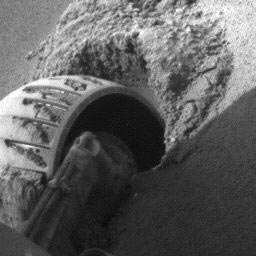

International Space Station
International Space Station Continuing on from the United States' Skylab and Russia's Mir, the International Space Station (ISS) represents a permanent human presence in space. The space station is located in orbit around the Earth at an altitude of approximately 386 km, a type of orbit usually termed low Earth orbit. (The actual height varies over time by several kilometres due to atmospheric drag and reboosts.) It orbits Earth at a period of about 92 minutes; on December 1, 2003 it had completed over 28,700 orbits since launch. It is serviced primarily by the Space Shuttle, and Soyuz and Progress spacecraft units. It is still being built, but is home to some experimentation already. At present, the station has a capacity for a crew of three, who
Space Shuttle Discovery
Space Shuttle Discovery Shuttle Orbiter Discovery (NASA Designation: OV-103) is a NASA Space Shuttle. First flown on August 30, 1984, Discovery is the third operational shuttle (excluding test shuttle 'Enterprise'). The orbiter is still operational today, and has performed both research and International Space Station (ISS) assembly missions. The craft takes its name from a ship used by explorer James Cook. Table of contents showTocToggle("show","hide") 1 Flights 1..1 Related articles 1..2
Image : Opportunity's left front wheel. Image credit: NASA/JPL.

NASA's Rovers Continue Martian Missions 05.24.05 -- NASA's Mars rover Opportunity is trying to escape from a sand trap, while its twin, Spirit, has been busy finding new clues to a wet and violent early Martian history.
Teacher in Space Project
Teacher in Space Project Christa McAuliffe (left) and Barbara Morgan pose in front of the Space Shuttle mission simulator (SMS) after their selection for TISP. The Teacher in Space Project (TISP) is a NASA program designed to educate students and spur excitement in math, science, and space exploration. Christa McAuliffe was selected to be the first teacher in space in 1984 with Barbara Morgan as her alternate. McAuliffe died during the launch of the 25th Space Shuttle mission, STS-51-L, which was to make her the first teacher in space. NASA halted the TISP until 1998 amid concerns surrounding the risk of sending civillians to space. Morgan was selected as the first Educator Astronaut in January, 1998. Morgan is assigned to the crew of STS-118 which may launch
The last remaining debate was over the nature of the boosters. NASA had been looking at no less than four solutions to this problem, one a development of the existing Saturn lower stage, another using "dumb" pressure-fed liquid fuel engines of a new design, and finally either a large single solid rocket, or two (or more) smaller ones. The decision was eventually made on the smaller solids due to their lower development costs (a decision that had been echoed throughout the whole Shuttle program). While the liquid fueled systems provided better performace and enhanced safety, delivery capability to orbit is much more a function of the upper-stage performance and weight than the lower. The money was simply better spent elsewhere.
The Air Force relucantly agreed, but only after demanding a large increase in capability to allow for launching their projected spy satellites (mirrors are heavy). These were quite large, weighing an estimated 40,000 lbs, and needed to be put into polar orbit, which requires more energy to get to than the more common LEO. And since the AF also wanted to be able to abort after a single orbit (as did NASA), and land at the launch site (unlike NASA), the spacecraft would also require the ability to manuver significantly to either side of its orbital track to adjust for the launching point rotating away from it while in polar orbit - in a 90 minute orbit Vandenberg would move over 1,000 miles, whereas in a "normal" equatorial orbit NASA needed the range would be less than 400. This large 'cross-range' capability meant the craft had to have a greater lift to drag ratio than originally planned. This required the addition of bigger, heavier wings.
Space Shuttle Endeavour
Space Shuttle Endeavour Shuttle Orbiter Endeavour (NASA Designation: OV-105) is the most recent Space Shuttle orbiter to be built. Construction began in 1987 to replace the Challenger, lost in an accident in 1986. Endeavour was first launched in 1992. The orbiter is named for the HM Bark Endeavour, the ship commanded by 18th century explorer James Cook (which explains the British spelling). Table of contents showTocToggle("show","hide") 1 Flights 2 Related articles 3